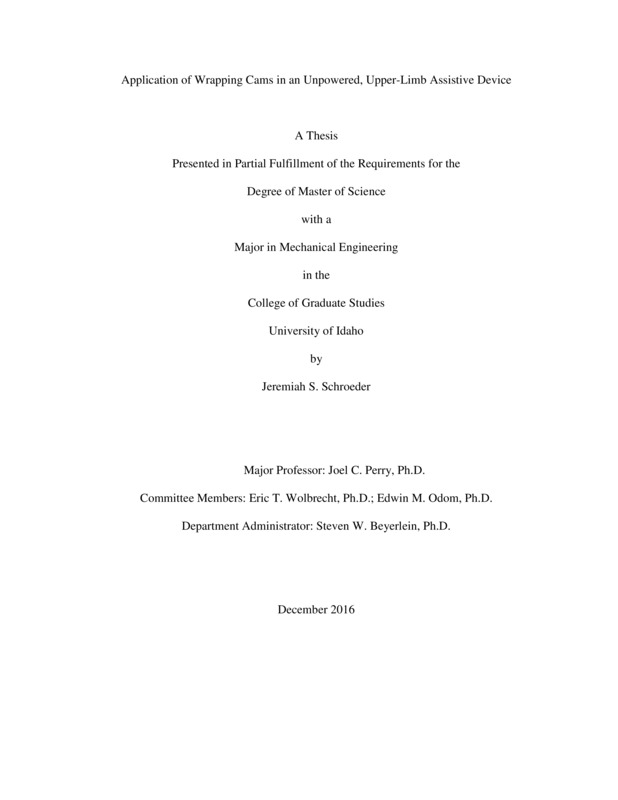Application of Wrapping Cams in an Unpowered, Upper-Limb Assistive Device
Schroeder, Jeremiah Scott. (2016). Application of Wrapping Cams in an Unpowered, Upper-Limb Assistive Device. Theses and Dissertations Collection, University of Idaho Library Digital Collections. https://www.lib.uidaho.edu/digital/etd/items/schroeder_idaho_0089n_11013.html
- Title:
- Application of Wrapping Cams in an Unpowered, Upper-Limb Assistive Device
- Author:
- Schroeder, Jeremiah Scott
- Date:
- 2016
- Embargo Remove Date:
- 2018-12-23
- Keywords:
- arm support assistive devices gravity balance simultaneous displacement stroke rehabilitation wrapping cams
- Program:
- Mechanical Engineering
- Subject Category:
- Mechanical engineering; Occupational therapy; Robotics
- Abstract:
-
This thesis presents the development of two novel gravity balance mechanisms for use in spring-based, wearable arm support devices for stroke rehabilitation. The first mechanism, called the series wrapping cam, uses a cam coupled to shoulder elevation to drive the rotation of a second cam, which in turn stretches a spring. The first cam, called the drive cam, gives the second cam, called the spring cam, a high mechanical advantage when the arm is horizontal. This allows a low initial spring tension and spring cam radius. This mechanical advantage decreases as the arm is lowered, optimally utilizing the available rotation of the cams. A two degree of freedom prototype arm support was constructed to demonstrate the application of the series wrapping cam as an arm support mechanism. The prototype features a lightweight, compact spring made from latex tubing. A series cam mechanism was synthesized which uses this spring’s full linear range of motion, minimizing the size of the spring. Vectran synthetic fiber rope was used as the wrapping element in the cams due to its tolerance to bending. The series wrapping cam prototype creates the correct general torque profile for an arm support, but the prototype does not respond appropriately to elbow flexion. The second mechanism was designed to couple elbow flexion with a support mechanism on the upper arm. It uses wrapping cams to apply the simultaneous displacement method for energy free adjustment of gravity balancers. A three degree of freedom prototype was constructed to demonstrate this mechanism. The prototype is able to support the upper arm, adjust the upper-arm support in response to elbow flexion/extension, and support elbow flexion using only one spring mechanism placed alongside the upper arm. Of the 4 anthropomorphic degrees of freedom from the glenohumeral joint to the elbow, the prototype excludes shoulder internal/external rotation. Future improvement and applications of the mechanisms are discussed.
- Description:
- masters, M.S., Mechanical Engineering -- University of Idaho - College of Graduate Studies, 2016
- Major Professor:
- Perry, Joel C
- Committee:
- Wolbrecht, Eric T; Odom, Edwin M
- Defense Date:
- 2016
- Identifier:
- Schroeder_idaho_0089N_11013
- Type:
- Text
- Format Original:
- Format:
- application/pdf
- Rights:
- In Copyright - Educational Use Permitted. For more information, please contact University of Idaho Library Special Collections and Archives Department at libspec@uidaho.edu.
- Standardized Rights:
- http://rightsstatements.org/vocab/InC-EDU/1.0/

